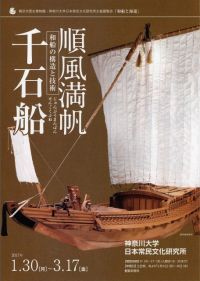Exhibition co-hosted by the Yokohama History Museum and the Institute for the Study of Japanese Folk Culture, Kanagawa University “Japanese Vessels and Maritime Trade”
Kanagawa University: Smooth Sailing on Sengoku-bune Freight Ships: The Structures and Techniques of Traditional Japanese Vessels[End]
[Exhibition Period] Monday, January 30 – Friday, March 17, 2017, admission free
[Venue] Kanagawa University, Yokohama Campus, Building 3, Exhibition Hall
[Opening hours] Monday – Friday 9:00 a.m. – 5:00 p.m. *Please enter by 4:30 p.m.
[Closed on] Saturdays, Sundays and holidays; Monday, February 6 – Wednesday, February 8
During the Edo period, domestic freight was transported mainly by coastal trading vessels called Bezaisen and other cargo ships. Large Bezaisen with a capacity of 150 tons, or 1,000 koku, were called Sengoku-bune and became the most common type of the era. The structures of Japanese vessels were different from those of Chinese and Western counterparts, thus requiring unique shipbuilding techniques and tools. Bezaisen were characterized by large single sails whose strong motive power has been demonstrated in recent replica sailing.
In this exhibition, the unique features of traditional Japanese vessels, Bezaisen in particular, are explained in a comprehensible manner through model ships, reference materials and picture panels on shipbuilding tools. Moreover, a life-size partial Bezaisen replica with a capacity of 15 tons, or 100 koku, produced by Tomoichiro Kondo, is displayed in the lobby of the first floor of the basement.
- ACCSESS
- Kanagawa University Exhibition Hall
-
 Higaki Kaisen
Higaki Kaisen
-
 A life-size replica of a coastal trading Bezaisen vessel with a capacity of 15 tons, or 100 koku
A life-size replica of a coastal trading Bezaisen vessel with a capacity of 15 tons, or 100 koku
-
 Panel display
Panel display
-
 A votive plaque for ships: a photograph of the original plaque stored in Enkakuji Temple in Aomori Prefecture
A votive plaque for ships: a photograph of the original plaque stored in Enkakuji Temple in Aomori Prefecture
-
 Japanese (left) and Chinese (right) shipbuilding tools
Japanese (left) and Chinese (right) shipbuilding tools
-
 A shipbuilding tool called Tsubanomi
A shipbuilding tool called Tsubanomi
Displays
Section I: Traditional Japanese vessels – features and replica sailing – sophisticated ships specialized for coastal transport
Section II: Unique shipbuilding techniques – joining and processing shipbuilding materials
Section III: Various types of Japanese vessels – Goza-bune ships used by aristocrats and high-ranking warriors, cargo ships, fishing boats and riverboats
Section IV: Chinese and Western vessels in comparison with Japanese ships
Lecture in the field: Understanding Ema votive plaques for ships
Lecturer: Masaaki Kon
Date: 2:00 p.m. – 3:30 p.m., Friday, March 17, 2017
Venue: Kanagawa University, Yokohama Campus, Building 3, Room 206
Capacity: 70 participants; first come, first served; admission free
Contact
Institute for the Study of Japanese Folk Culture
Kanagawa University
Address: 3-27-1, Rokkakubashi, Kanagawa-ku, Yokohama-shi,
Kanagawa, 221-8686, JAPAN
Email: jomin-office@kanagawa-u.ac.jp
Tel: +81-(0)45-481-5661
Fax: +81-(0)45-413-4151


